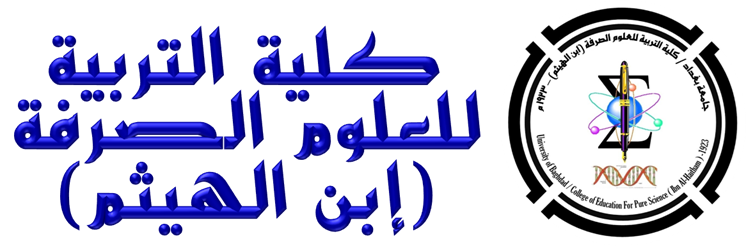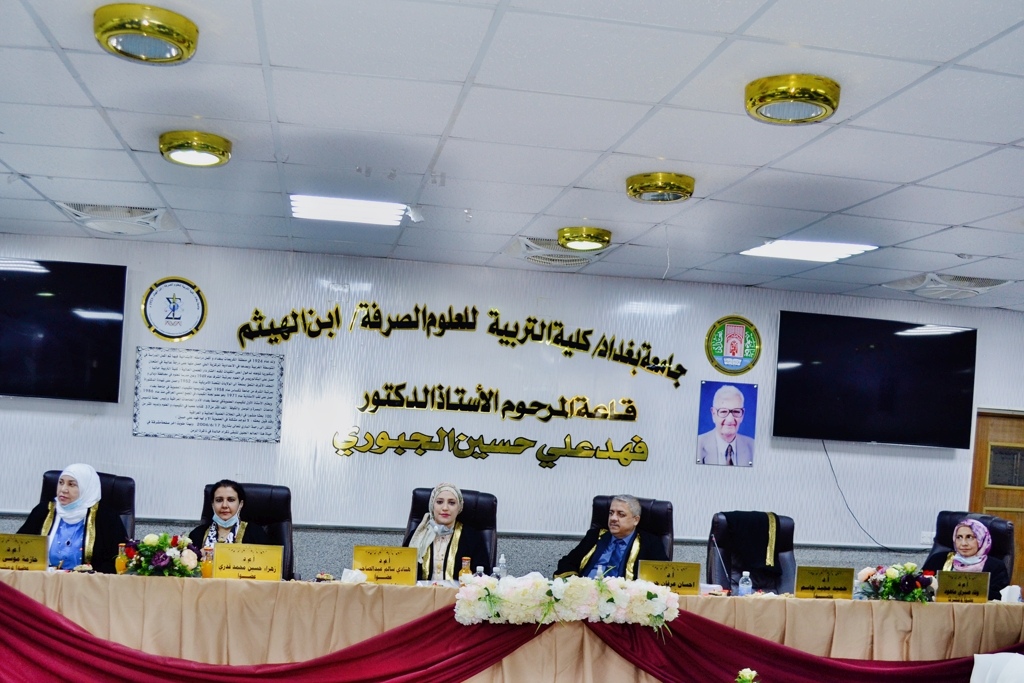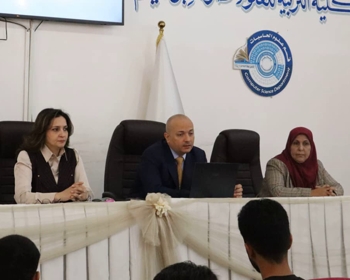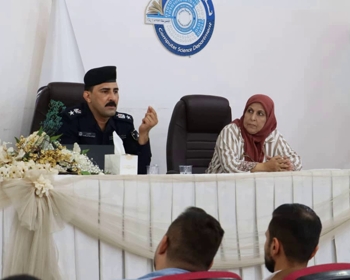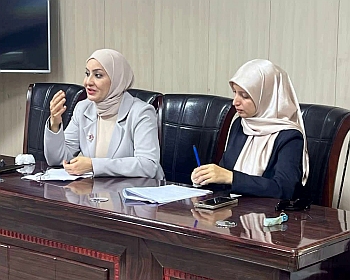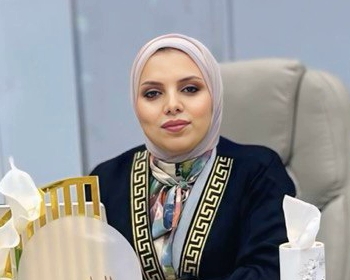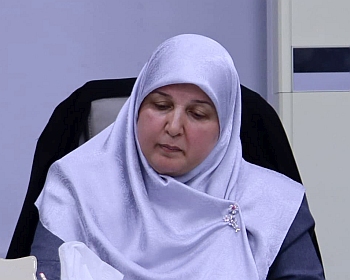ناقش قسم علوم الحياة في كلية التربية للعلوم الصرفة (ابن الهيثم) أطروحة الدكتوراه الموسومة (دراسة وراثية مناعية لجينات عامل النمو المحوّل – بيتا TGF-β ومستقبله الثالث TGF-βRIII ومستضد خلايا الدم البيض البشرية نوع -ج – HLA-G في النساء العراقيات المصابات بسرطان الثدي) للطالب (عادل عمران سلمان) التي انجزها تحت اشراف تدريسيتا القسم (أ.م.د. حازمة موسى خليل ) و (أ.م.د. وفاء صبري ماهود) ونوقشت من قبل أعضاء لجنة المناقشة المبينة أسمائهم فيما يأتي :
-
ا.د. احسان عرفان حسين (رئيساً)
-
ا.د. حميد مجيد جاسم (عضواً)
-
ا.د. ابراهيم هادي محمد (عضواً)
-
ا.م.د. زهراء حسين محمد قدري (عضواً)
-
ا.م.د. هنادي سالم عبد الصاحب (عضواً)
-
أ.م.د. حازمة موسى خليل (عضوا و مشرفا)
-
أ.م.د. وفاء صبري ماهود (عضوا ومشرفا)
هدفت الدراسة إلى تقييم دور الجينات المثبطة والتنظيمية لكل من (عامل النمو المحوّل – بيتا TGF-β ومستقبله الثالث TGF-βRIII ومستضد خلايا الدم البيض البشرية نوع -ج- HLA-G) في التسبب في الإصابة بسرطان الثدي لدى بعض النساء العراقيات ، ولتحقيق ذلك تم اعتماد العديد من الخطوات الاتية :
-
تحديد القياسات او الخصائص البشرية والمرضية لجميع المرضى وتقييم ارتباط بعض الخصائص بالتعبير الجيني Gene expression وبتعدد الأشكال الجيني Gene polymorphism للجينات المثبطة والتنظيمية التالية HLA-G , TGF-β1 , TGF-β3 و TGF-βRIII.
-
دراسة التنميط الجيني Genotyping لتعدد الأشكال الجيني للجينات HLA-G ، TGF-β1 و TGF-βRIII باستخدام تقانة تفاعل البلمرة المتسلسل التقليدي Conventional PCR والتسلسل التتابعي للحمض النووي DNA sequencing.
-
تحديد التعبير الجيني وتقييمه للجينات HLA-G، TGF-β3 و TGF-βRIII باستخدام تقنية الوقت الحقيقي لتفاعل البلمرة المتسلسل الكمي (RT-qPCR).
جميع عينات هذه الدراسة تم جمعها من النساء العربيات العراقيات المصابات حديثاً بسرطان الثدي بمتوسط عمر (51.18 ± 10.64) بالإضافة إلى 40 عينة دم من النساء الأصحاء كمتطوعات (سيطرة) . تمت مقابلة النساء الأصحاء والمريضات المصابات بسرطان الثدي واستجوابهن وفق استمارة خاصة والمدرجة في الملاحق ، للحصول على معلومات القياسات البشرية , بينما تم الحصول على الخصائص السريرية والنسيجية لأورام المرضى من سجلاتهم الطبية ، بعد الحصول على الموافقة الأخلاقية.
تضمنت هذه الدراسة جزأين من دراسات الوراثة المناعية , شمل الاول دراسة التنميط الجيني لجينات مستضد خلايا الدم البيض البشرية نوع-ج- HLA-G , عامل النمو المحوّل – بيتا1 TGF-β1 ومستقبله الثالث TGF-βRIIIوالتي اجريت باستخدام تقانة تفاعل البلمرة المتسلسل التقليدي (PCR) وتم التحقق من النتائج بأستعمال تفاعل التسلسل التتابعي Sequencing . والثاني شمل دراسة التعبير الجيني وتقييمه بأستخدام تقانة الوقت الحقيقي لتفاعل البلمرة المتسلسل الكمي (RT-qPCR) لجينات HLA-G , TGF-β3 و TGF-βRIII. لتحليل جزيئاتها المثبطة والتنظيمية وتقييم دورها في التسبب في الإصابة بسرطان الثدي لدى بعض الإناث العربيات العراقيات.
تضمنت دراسة تعدد الأشكال الجيني المظهري لكل من الجينات التالية : مستضد خلايا الدم البيض البشرية نوع –ج HLA-G وامكانية تحديد العلاقة المرافقة بين تكرار تعدد الأشكال (14 زوج قاعدة) .14-bp insertion/deletion في المنطقة المشفرة 8 للمنطقة غير المترجمة 3` مع خطر الأصابة بسرطان الثدي ، عامل النموالمحوّل- بيتا 1 ( (TGF-β1 والمستقبل الثالث لعامل النمو المحوّل-بيتا (TGF-βRIII) باستخدام تقانة تفاعل البلمرة المتسلسل التقليدي (PCR) . وتم استعمال تفاعل التسلسل التتابعيي Sequencing للحامض النووي DNA باستخدام تقانة سانجر Sanger لمعرفة التنوع الجيني في منطقة المحفز Promoter region لكل من جيني TGF-β1 ومستقبله الثالث TGF-βRIII.
كما تم تحديد مستوى التعبير الجيني لكل من الجينات التالية: HLA-G , TGF-β3 و TGF-βRIII باستخدام تفاعل البلمرة المتسلسل الكمي في الوقت الحقيقي (RT-qPCR) وتحديد الخصائص للقياسات البشرية والمرضية لجميع المرضى وتقييم الارتباط بين هذه المستويات من التعبير الجيني وتعدد الأشكال الجيني للجينات المثبطة والتنظيمية HLA-G , TGF-β1 , TGF- β3 و TGF-βRIII.
أظهرت نتائج هذه الدراسة أنه تم تسجيل فروق ذات دلالة إحصائية عالية بين معظم الخصائص الديموغرافية والمرضية السريرية لسرطان الثدي عند النساء , وان أعلى معدل للإصابة بسرطان الثدي لوحظ بين النساء في العقد السادس والخامس من العمر ، واغلب النساء المصابات بسرطان الثدي في الدراسة الحالية كانت موجبة للأستروجين +ER والبروجستيرون +PR و سالبة لعامل نمو البشرة HER2- . غالبية سرطان الثدي لدى النساء العراقيات كان سرطان الثدي الغازي (100٪) , اذ شكل سرطان الأقنية الغازية نسبة 91.7٪ , وكان النوع الفرعي الجزيئي الأكثر عدوانية هو سرطانات النوع Luminal A. كانت معظم الاورام في الدرجة الثانية (76.7٪) و المرحلة الثانية 43.3٪ . أظهرت نتائج حجم الورم أن نسبة عالية من المرضى 46/60(76.7%) بلغ عندهن حجم الورم أكثر من 2 سم وأن 37 مريضاً 61.7٪ كان لديهن انبثاث بالورم في العقدة الليمفاوية.
استخدمت تقانة تفاعل البلمرة المتسلسل التقليدي لتكثير الجين واظهرت نتائج هذا التقانة اثنين من الحزم ( ادخال +14 او حذف -14 ) للقطعة – 14زوج قاعدة للجين HLA-G والتي كانت 210 زوج قاعدة او224 زوج قاعدة بالتعاقب والتي ميزت بواسطة الترحيل الكهربائي على هلام الأكروز 2%.
كشفت نتائج تعدد الأشكال الوراثي لجين HLA-G عن ثلاثة أنماط وراثية: متماثل الجينات +14bp/+14bp (ادخال / ادخال) ، متماثل الجينات -14bp/-14bp ( حذف / حذف) ومتغاير الجينات +14bp/-14bp( ادخال / حذف ) ، كشفت النتائج أن التكرارات المقدرة للطراز الوراثي متماثل الجينات) +14bp/+14bp ادخال/ ادخال ) كانت أعلى بين المرضى (26.7%) مقابل السيطرة (12.5%) (OR=2.55, 95%CI=0.86-7.54 , P=0.088) . وظهر هذا النمط كطراز وراثي مسبب ومرتبط بالمرض Etiological fraction(EF) بلغت قيمته 0.16 , كما كانت قيمة النسبة الحرجة OR تساوي 2.55 ومدة الثقة CI كانت قيمتها بين 0.86-7.54 وبالمثل ، كان تردد أليل الإدخال (ins ) HLA-G 14-bp أعلى في المرضى (51.7٪) مقابل السيطرة (40٪) ( OR=1.60, 95%CI=0.91-2.83 , P=0.105 ) ، وظهر اليل الأدخال ins كاليل مسبب Etiological fraction(EF) بلغت قيمته 0.19 ومرتبط مع المرض, اذ كانت قيمة النسبة الحرجة OR تساوي 1.60 ومدة الثقة CI كانت قيمتها بين 0.91-2.83 , مع عدم وجود فروق ذات دلالة إحصائية في مستويات النمط الجيني والأليلي بين المرضى ومجموعات السيطرة عند مستوى احتمالية p≤0.05 وعند استعمال اختبار فيشر، وتشير هذه النتائج الحالية إلى وجود ارتباط بين القابلية للإصابة بسرطان الثدي والنمط الوراثي ادخال / ادخال واليله للجين HLA-G 14-bp ، يمكن النظر فيه كعامل خطر وراثي محتمل في بدء وتطور سرطان الثدي.
كشفت نتائج التسلسل التتابعي Sequencing وتعدد الأشكال الوراثي للجين TGF-β1 509T/C (rs1800469) عن ثلاثة طرز وراثية (TT ، TC و CC). ووجد أن النمط الوراثي متغاير الجينات (TC) سجل ترددًا عاليًا في المرضى 32/60 (53.3%) بالمقارنة مع السيطرة 19/40(47.5%) ، وكان OR=1.26, 95%CI=0.57-2.79 , P=0.568)) , وكذلك كان تردد النمط الوراثي متماثل الجينات (TT) هو الأخر أعلى قليلاً في المرضى 11/60 (18.3%) من السيطرة 7/40(17.5%) OR=1.06, 95%CI=0.38-2.98 , P=0.915)) . وظهر هذان النمطان الوراثيان TT و TC كنمطين وراثيين مسببين ومرتبطين مع خطر الأصابة بسرطان الثدي Etiological fraction(EF) بلغت قيمته 0.01 و 0.11 , على التوالي. وبالمثل ، كان تواتر الأليل T أعلى في المرضى (45٪) مقارنة بالضوابط (41.3٪) (OR = 1.17 , 95% CI=0.66-2.06 , P = 0.6) ، وظهر كاليل مسبب Etiological fraction(EF) بلغت قيمته 0.06 ومرتبط مع المرض في عينة المصابين , بينما ظهر الأليل C كأليل وقائي من المرض Preventive fraction (PF) وبلغت قيمته 0.08، مع عدم وجود فروق ذات دلالة إحصائية بين المرضى والضوابط عند مستوى احتمالية ( p≤0.05) , أظهرت النتائج الحالية وجود ارتباط بين القابلية للإصابة بسرطان الثدي والنمطين الجينيين TC و TGF-β1 (rs 1800469) TT كعامل خطر وراثي محتمل في تطور المرض إذا تم تحريضه بواسطة العوامل البيئية الخارجية في الأفراد المجهزين وراثيا .
أظهرت نتيجة التضخيم الجيني للجين TGF-βRIII نطاقًا واحدًا لكل عينة جزيئية (457 نقطة أساس) ونتائج تسلسل الحمض النووي وتعدد الأشكال الوراثي أظهرت ثلاثة طرز وراثية (GG ، GC و CC). أظهرت هذه النتائج الحالية ارتباطًا بين قابلية الإصابة بسرطان الثدي والطراز المظهري TGF-βRIII 457-bp CC و اليله C كعامل خطر وراثي محتمل في تطور المرض.
ظهر الأليل C كاليل مسبب Etiological fraction(EF) بلغت قيمته 0.04 ومرتبط مع المرض في عينة المصابين , بينما ظهر الأليل G كأليل وقائي من المرض Preventive fraction (PF) . اظهرت نتائج التحليل الأحصائي للنمط الوراثي CC نسبة اعلى عند المرضى 3.3% بالمقارنة مع السيطرة 0.0% وظهر هذا النمط كنمط وراثي مرتبط مع خطر الأصابة بسرطان الثدي.
أظهرت نتائج الدراسة الجزيئية (التعبير الجيني) زيادة معنوية عالية في مستوى التعبير الجيني لدى المرضى 0.54 ± 0.62 و 4.57 ± 5.50 لجينات HLA-G و TGF-β3 على التوالي مقارنة بمجموعة التحكم (0.28 ± 0.23) و 2.64 ± 2.49) لجينات HLA-G و TGFβ3 , على التوالي. بينما أظهرت النتائج الحالية أن طية التعبير عن جين TGF-βRIII قد انخفضت في مرضى سرطان الثدي (1.457 ± 2.10) مقارنة بالضوابط (2.10 ± 2.63) مع عدم وجود فرق معنوي عند P≤0.05.
وفي الختام ، تشير نتائج الدراسة الحالية إلى أن تعدد الأشكال الأكثرتكراراً هو النمط الجيني المتماثل للإدخال insertion/insertion وأليله insertion للجين ـ HLA-G 14-bp في النساء العراقيات المصابات بسرطان الثدي ، ويمكن اعتباره عامل خطر وراثي محتمل في بدء و تطور سرطان الثدي . في حين أن النمطين الجينيين TT و TC لتعدد الأشكال للجين TGF-β1 والنمط الجينيCC للجين TGFβRIII وأليله C قد يعززان قابلية الإصابة بسرطان الثدي , كما سجلت النتائج زيادة معنوية عالية في مستوى التعبير الجيني لكل من جين HLA-G وجين TGF-β3 لدى مرضى سرطان الثدي, وأخيرًا وجدت أن طية التعبير عن جين TGF-βRIII قد انخفضت في مرضى سرطان الثدي مقارنةً بالضوابط.
Immunogenetic Study on TGF-β, TGF-βRIII and HLA-G Genes among
Iraqi Women wih Breast Cancer
By Adel Omran Salman Hasan
Supervised by Asst.prof.Hazima Mossa and Asst.prof.Waffa’a Sabri Mahmood
Aims of the Study
This investigation aimed to evaluate the role of inhibitory and regulatory genes HLA-G, TGF-β1, TGF-β3 and TGF-βRIII in the pathogenesis of breast cancer in some Iraqi females, so to achieve this goals ,many objectives were adopted
Determine the Anthropometric and pathological characteristics for all patients and asses the correlation of some properties with the gene expression and gene polymorphism for the inhibitory and regulatory genes HLA-G, TGF-β1, TGF-β3 and TGF-βRIII
Geno typing the HLA-G, TGF-β1and TGF-βRIII genes polymorphism by using the conventional PCR technique and DNA sequencing
Determine the gene expression of HLA-G, TGF-β3 and TGF-βRIII genes by using Real time quantitative PCR technique (RT-qPCR)
Abstract
The study was aimed to investigate the role of inhibitory and regulatory genes in the pathogenesis of breast carcinoma. This study was included 60 Peripheral blood samples which withdrawn from early diagnosed breast cancer patients which attended to Oncology Teaching Hospital of the Medical City in Baghdad at the period from May 2019 until February 2020. All collected samples from Iraqi women suffer from breast cancer with average age mean 51.18 ± 10.64 in addition to 40 blood samples from apparently healthy women as volunteers. The healthy women and patients with cancer were interviewed and underwent to a questionnaire according to a special form which listed in appendices to get the anthropometric information, however, the clinical and histological properties about the patients tumors were obtained from their medical report, in addition ethical approval.
This study was implied two-parts of immunogenetic studies, the first is the genotyping of human leukocyte antigen –G (HLA-G), transforming growth factor-beta1 (TGF-β1) and transforming growth factor beta receptor III (TGF-βRIII) genes were performed by conventional polymerase chain reaction (PCR). The results were verified by sequencing technique. The second is the gene expression, which was evaluated by quantitative reverse transcription polymerase chain reaction (RT-qPCR) technique for HLA-G, TGF-β3 and TGF-βRIII genes, for analyzing their inhibitory, regulatory genes and assessing their role in the pathogenesis of breast cancer in some Iraqi females.
In regard to HLA-G, it has been investigated the possible etiological role of 14-bp insertion/deletion polymorphism in exon 8 of 3` untranslated region (3`UTR) with the risk and predisposition of breast cancer, while TGF-β1 and TGF-βRIII were investigated by DNA sequencing using automated Sanger technique to determine the genetic variation in the promoter region of both TGF-β1 and TGF-βRIIIgenes. In addition to determine the level of gene expression for HLA-G, TGF-β3and TGF-βRIII genes by using RT-qPCR. The investigation of the association of some anthropometric and pathological characteristics with gene polymorphism and gene expression for all of the inhibitory and regulatory genes (i.e. HLA-G, TGF-β1, TGF- β3 and TGF-βRIII).
The results of this study showed high significant differences between the most demographic and clinico pathological characteristics of breast cancer women. The highest incidence of breast cancer noted among women in their fifth and sixth decades of life, and the most breast cancer women in current study were Estrogen receptor (ER),Progesterone receptor (PR) positive and human epidermal growth factor receptor-2 (HER-2/neu) negative. The majority of breast cancer in Iraqi women was invasive breast carcinoma (100%) in which invasive ductal carcinoma constitutes 91.7%, and the most aggressive molecular sub type was luminal like A carcinoma. Most histological tumor grades were 76.7% for moderately differentiated (GII) and Stage II were 43.3%. The results of tumor size showed that 46 /60 (76.7%) of patients were with more than 2 cm tumor size and 37/60(61.7%) of patients had lymph node metastasis.
PCR amplification was used for detection of insertion or deletion of the 14bp sequence in HLA-G generated PCR products of length 210bp or 224bp, respectively, and distinguished by 2% agarose gel electrophoresis.
Genetic polymorphism results of HLA-G gene were observed with three genotypes: homozygous for the +14bp/+14bp (ins/ins), homozygous -14bp/-14bp (del/del), and heterozygous +14bp/-14bp (ins /del).The results revealed that estimated frequencies of the homozygous +14bp/+14bp (ins/ins) genotype was higher among patients 16/60 (26.7%) versus controls 5/40(12.5%) (OR = 2.55, 95% CI= 0.86-7.54, P=0.088), this genotype revealed as Etiological fraction (EF) and correlated with risk by having this disease. Similarly, the HLA-G 14-bp insertion allele (ins) frequency was higher in patients (51.7%) versus controls (40.0%) (OR=1.60, 95% CI=0.91-2.83, P=0.105), the (ins) allele revealed as Etiological fraction (EF) and correlated with the disease in patients sample, With no significant difference found at allelic and geno type levels between the case and control groups at P≤0.05, and according to Fishers exact probability. These present results suggested an association between breast cancer susceptibility and HLA-G 14-bp ins/ins and its allele (ins), it may be consider as a potential genetic risk factor in the initiation and progression of the breast cancer.
The results of DNA sequencing and genetic polymorphism of TGF-β1 gene 509 T/C (rs1800469) showed three genotypes TT, TC and CC. The heterozygous genotype (TC) was recorded high frequency in patients 32/60 (53.3%) as compared with controls 19/40 (47.5%), and the OR was 1.26 (95% CI = (0.57-2.79, P=0.568). The homozygous genotype (TT) frequency was slightly higher in patients 11/60 (18.3%) than controls 7/40 (17.5%) (OR= 1.06, 95% CI = 0.38-2.98, P= 0.915). The TT and TC genotypes revealed as etiological fraction (EF) with risk by having this disease. Similarly the frequency of the T allele was higher in patients (45%) versus controls (41.3%) (OR= 1.17, 95% CI = 0.66-2.06, P= 0.6), and revealed as Etiological fraction (EF) and correlated with the disease. Whereas the C allele revealed as Preventive fraction (PF). With no significant differences recorded between patients and controls at (P≤0.05) and according to Fishers exact probability. Present results showed an association between breast cancer susceptibility and TGF-β1(rs 1800469). This study demonstrates that the T-509 C SNP (TT and TC)geno types are significant clinical risk factor in the progression of the disease.
The result of TGF-βRIII gene amplification showed a single band for each sample with 457 bp molecular and the results of DNA sequencing and polymorphism showed three genotypes GG, GC and CC, also the results showed an association between breast cancer susceptibility and TGF-βRIII 457-bp (CC and C) as a potential genetic risk factor in the initiation progression of the disease. The C allele revealed as (EF) and correlated with the disease in patient’s sample, whereas the G allele revealed as Preventive fraction (PF). The homozygous genotype (CC) frequency was higher in patients (3.3%) versus controls (0.0%) and this genotype revealed as (EF) correlated with breast cancer.
Gene expression results showed high significant increasing in level of gene expression in patients 0.54 ± 0.62 and 4.57 ± 5.50 for HLA-G and TGF-β3 genes, respectively, as compared to control group 0.28 ± 0.23 and 2.64 ± 2.49. While, the present results showed that expression fold of TGF-βRIIIgene was decreased in breast cancer patients (1.457 ± 2.10) as compared to controls (2.10 ± 2.63) with no significant difference was found. A significant difference was noted between expression fold of HLA-G gene and genotype frequency for TGF-βRIII in breast cancer patients P=0.013. Also, a significant association was noted between expression fold of TGF-βRIII gene with genotype frequency for TGFβ1 in breast cancer patients P=0.001. A higher level of expression of the TGF-β3 gene correlated with patients at categories of 40-49 years of age (P=0.005).
In conclusion, the results of the current study demonstrated, that the most frequencies polymorphism is the homozygous insertion genotype of HLA-G 14-bp and its allele in Iraqi Arabian breast cancer women, and may consider a potential genetic risk factor in the initiation and progression of the breast cancer. While, TT and TC genotype for TGF-β1polymorphism and TGF-βRIII CC genotype and its allele C may enhance the susceptibility of breast cancer. Also, the results was recorded that high significant increasing of HLA-G and TGF-β3 gene expression level in breast cancer patients, and finally found that expression fold of TGF-βRIII gene was decreased in breast cancer patients as compared to controls.
